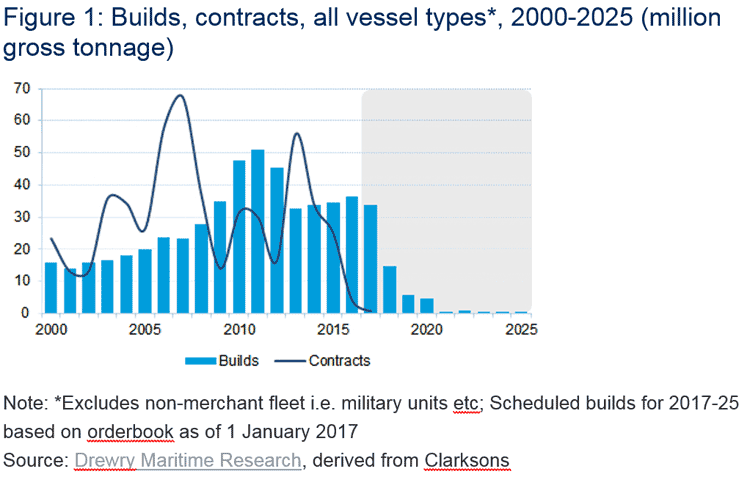After many years of adding new capacity, generally far in excess of demand, container and bulk ocean carriers have pulled the plug on new orders, leaving ship builders in a lurch and questions about how they can survive the drought.
2016 was the worst on record for new contracts of merchant ships, according to data from Clarksons Research Services. The data shows that only 4 million gross tonnes of new orders were placed, down from 25 million in 2015. That total was less than half the the five-year peak of 56 million gross tonnes in 2013.
Supply Chain Digest Says... |
|
|
The number was as high as 70 million tonnes in the peak year of 2007.
The dramatic decline in orders will see ship building yards around the world, such as those in South Korea, China and Japan, with fewer and fewer ships to build, to the points that new work will almost run dry after 2018 absent of change in direction very soon.
This scenario is illustrated in the graphic below developed by the analysts at Drewry Research, based on the Clarksons data.
Seeing this disaster in the making, the Korean government is taking actions to save its ship building industry, which employs an estimated 200,000 people in the country. For example, Korea's government designated the shipping sector as a special industry eligible for government support, after saying as many as 60,000 jobs could be lost in the short term from the order drought.
Drewry doesn't see the situation likely to change any time soon, noting that "The chances of the orderbook flashing back into life are not high."
It adds that "Many [ship] owners are already well-stocked with young and cost-effective ships after big order sprees in the last decade, while following prolonged shipping losses capital is scarcer."
The on-going over capacity situation is the result of years of new deliveries (especially megaships with 18,000+ TEU capacity) that far exceeded growth in container volumes. That has sent rates tumbling, leading to huge losses at the carriers.

However, a few carriers are likely to start placing orders again. That includes Hyundai Merchant Marine, trying to pick up the pieces from bankrupt fellow Korean container carrier Hanjin Shipping Co. and Islamic Republic of Iran Shipping Lines (IRISL), to expand which wants to expand signficantly.
But Drewry says ship builders will likely need to offer big discounts to get ocean carriers to place new orders, which might tempt some of them to do so even though the industry still has too much TEU capacity.
Drewry adds that "The vulnerable position of the shipyards gives containership operator-owners a window of opportunity to smooth out the delivery of the new builds to which they are committed and to massage the supply/demand balance more in their favor."
(See More Below)
|
CATEGORY SPONSOR: SOFTEON |
|
|
| |
|
|
For example, Maersk Line, the largest container carrier by revenues and capacity, recently announced that it will push back delivery of nine 14,000 TEU ships originally due for delivery at the end of this year from South Korean shipyard Hyundai Heavy Industries to the end of 2018. Maersk said the deferral came at no cost and that it simply does not need the ships for now, being able as it is to look to the currently cheap charter market to meet its needs.
In addition, Maersk and other carriers are said to be quietly snatching up former Hanjin ships on the cheap, further reducing the need for new vessels.
However, the almost complete end of new ship orders recently and deferrals such as what Maersk is doing doesn't mean new ships previously ordered aren't still coming - at least for the very short term.
Drewry says even after Maersk's deferral there is approximately 1.6 million TEU worth of new container ship capacity scheduled for delivery in 2017, which includes some carried over from 2016.
"That is still an awful lot of additional capacity to absorb in one go, especially for an already over-supplied market that has had to idle over 1 million TEU of unwanted ships," Drewry notes.
In fact, more total capacity will be delivered in 2017 than the year before.
As seen in the chart below, however, ship deliveries will slow down still further in 2018, and fall to almost nothing in years beyond that unless new orders once again start to arrive.

In the end, Drewry believes carriers should take the opportunity to hold off on adding capacity to bring supply better in balance with demand, sending rates back up. But in good news for shippers, Drewry thinks it's likely they will not be so disciplined.
"Carriers probably won't fully seize on the opportunity to narrow the difference between supply and demand growth - but they should," Drewry writes. "The window might not last too long if government stimulus has the desired affect and rekindles the shipbuilding industry."
Do you think carriers will have the discipline to stop adding capacity - or will sweet deals lure them back to new order. Let us know your thoughts at the Feedback section below.
Your Comments/Feedback
|